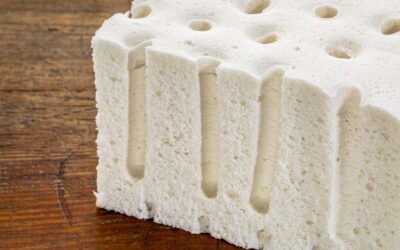Drying of latex and foam is an important step in it’s manufacturing process as it affects the quality and properties of the final product. During the drying process, the water content in the latex or foam is reduced to a level where it can be further processed or used.
However, drying latex and foam can be challenging as it is a time-consuming process and can ruin the long-term quality, if not done correctly. Some of the difficulties in drying latex and foam include maintaining the optimal temperature, avoiding cracking and deformations, avoiding steam pockets, and achieving uniform drying. The best solution to dry latex and foam during the manufacturing process is to use a radio frequency drying. This approach ensures that the temperature is maintained at the desired level, reduces drying time, and results in a uniformly dried product with improved quality and properties, and is cost effective.
Radio Frequency Drying for Latex and Foam
Radio frequency (RF) drying is a technology that uses high-frequency electromagnetic fields to heat and eventually vaporise water molecules within the latex product. In the manufacturing of latex and foam, RF drying is used as an alternative or complement to traditional convective drying methods.
During RF drying, the latex or foam is subjected to an RF field, which causes the water molecules in the material to vibrate and generate heat. This heat results in the evaporation of moisture, reducing the water content of the material. Because RF drying heats the water directly, it can achieve faster drying times at lower drying temperatures than convective drying methods, which rely on hot air to remove moisture.
In addition to faster drying times, RF drying also offers several other benefits in the drying of latex and foam during the manufacturing process. For example, RF drying can produce a more uniform and consistent drying process, which results in improved product quality and reduced risk of cracking, deformation or yellowing. It can also be used for materials with high moisture content, where traditional convective drying methods may not be effective. This is because RF heating raises the temperature of the entire product simultaneously as opposed to convective heating which relies on the heat transfer properties of the product and necessitates the outer case of the material to be hotter than the core. This results in thermal stresses, cracking, and yellowing due to overheating of the outer layers.
Industries which use RF Dryers for Drying Latex and Foam
Radiofrequency (RF) dryers are used in a variety of industries that produce latex and foam products. Some of the main industries that use RF dryers include:
- Mattress and bedding industry: RF dryers are commonly used in the manufacturing of foam mattresses, pillows, and other bedding products.
- Upholstery industry: RF dryers are used in the production of foam cushions, seat backs, and armrests for furniture.
- Automotive industry: RF dryers are used in the production of foam for car seats, steering wheels, and other automotive parts.
- Packaging industry: RF dryers are used in the manufacture of foam packaging materials, such as foam inserts and foam cushions, to protect delicate products during shipping.
- Medical industry: RF dryers are used in the production of foam products for medical applications, such as wheelchair cushions, prosthetic devices, orthopedic braces, and medical PU foam.
RF Drying for Latex & Foam at Monga Strayfield
When Monga Strayfield’s RF Drying technology was installed and implemented at one of the leading Indian brands producing latex and foam mattresses, they saw some considerable differences in the way the process and product turned out, as compared to conventional drying methods. Some of the advantages and observations, as pointed out by the client, were:
- The machine requires only 1/3rd of the space as compared to conventional drying systems.
- Drying, which takes 15-18 hours through conventional methods can be completed within 1-2 hours using RF.
- A 125 kW RF drier has a capacity to process 6/7 beds per hour.
- RF Drying cuts down the manpower to only 30%, as compared to a conventional drying system.
- Fuel consumption, as compared to conventional drying, is reduced, and provides savings of 50-60%
- Latex or foam cannot be subjected to high temperatures as it leads to colour change in the product. RF drying provides uniform and consistent drying and avoids discolouration, and gives improved product quality.
- The RF dryer gives substantial savings in the long run. An approximate payback time of 2.5 years can be expected.
Overall, RF drying is a promising technology for the drying of latex and foam. Additionally, RF heating processes can also be used in combination with vulcanizers for efficient and cost-effective bonding of rubber molecules in natural latex foam. RF technology utilizes high-frequency electric fields to generate heat within the foam, which helps to efficiently heat and cure rubber products such as natural latex foam. RF dryers can be used to effectively produce both low-density and high-density foams.
RF dryers and vulcanizers also offer safety advantages, as RF technology neither uses nor produces hazardous chemicals and can reduce the chances of accidents occurring in the factory.
In conclusion, RF dryers and vulcanizers are essential components for the efficient and cost-effective production of quality natural latex foam, making them a sound investment for any latex foam factory.
